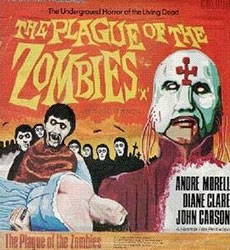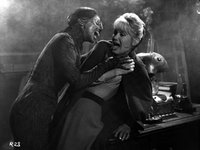So I’ve caved in and bought the first two volumes of the Ultimate Edition DVDs of the 007 films. Each volume contains a scattershot assortment of five films, seemingly chosen by some marketing exec firing rubber darts from a toy Walther PPK at a board with the Bond film titles hanging on it. None of the titles are available separately, so if you want a favourite film or two then you likely have to put up with plunking down sheckels for the odd film that is, well, kinda crap. 
So, volume 1 has some favourites (Goldfinger, The Living Daylights, The World is Not Enough), and two middling to bottom-drawer efforts (Diamonds are Forever, The Man with the Golden Gun). The scorecard for volume 2 is two favourites (Thunderball, Licence to Kill), two middling (The Spy Who Loved Me, Die Another Day), and one dreckfest (A View to a Kill -- tell me the use of the Beach Boys in the pre-credit sequence is not a travesty). So far, I’ve only seen three of the volume 1 films in their entirety and have sampled some of the rest.
For 007 fans, the sole compelling reason to pick up these sets is the complete digital restoration done on the films by Lowry Digital, who also handled the revamps of the Star Wars and Indiana Jones films. After buying Volume 1, I decided to test drive the picture restoration through a viewing of one of the older films, Goldfinger. And, man oh man, a beautiful sight it is too. The picture quality is far beyond anything I’ve seen on home video before; it is a gorgeous transfer to disc, excelling even the laserdisc incarnation that was previously the gold standard for this film. The film almost looks like it was shot yesterday. Stellar work.
Beyond the sterling picture quality, Goldfinger is an interesting viewing experience. Frequently cited as THE best in the series (which for my money is From Russia With Love), it is indeed a slick, fast, highly-engaging piece of entertainment, and the film that cemented James Bond’s position in pop culture. Sean Connery easily commands the film with smooth assurance, and the film contains many moments that have since become classic cinema. Who can forget the laser beam sequence and Goldfinger’s line “No, Mr. Bond, I expect you to die!” Plus there’s Q’s (Desmond Lewelyn) witty retort to Bond’s “Ejector seat, you’re joking!”: “I never joke about my work 007.” But what’s interesting is how the seeds of the jokiness that were to drag the series into the doldrums are planted here.
Bond wearing a wetsuit with a duck attached to the head is a funny gag but, come on, why the hell would a soggy fake duck on a wetsuit cap be even deemed to be necessary as a stealth device? The cartoon mobsters make their first appearance in a Bond film, jokey hoods that bear all the realism of Halloween costumes (the phoney baloney gangsters reappear, sadly, in Diamonds Are Forever). And it is only the most strong-willed amongst us that can successfully suppress giggles at the hundreds of soldiers dropping on cue to the ground as Pussy Galore’s flying circus belch out stun gas over Fort Knox. There are other moments that foreshadow the James Bond Comedies of the ’70s.
The person most to blame for this is director Guy Hamilton. Look at the interviews with Hamilton on the second disc. He clearly has no interest in making any of the film remotely plausible. Thankfully the comedic zing is reined in somewhat by a good screenplay that bears at least a passing resemblance to the Ian Fleming novel. When Hamilton didn’t have some Fleming in the mix to leaven the silly humour we got: Diamonds Are Forever, Live and Let Die, and The Man With the Golden Gun. Disco Bond.
Which takes me to Connery’s last appearance in the official Bond series, Diamonds Are Forever. In spite of being overweight and sporting a bad toupee and, in one of the most genuinely scary moments in the entire 007 film series, a hideous pink tie, Connery still delivers as Bond. But the tone of the film is way off, veering into silly comedy too often, and continuing the grand You Only Live Twice tradition of jettisoning the entire novel. Though the novel is one of the weaker books, the opening credit “…in Ian Fleming’s Diamonds Are Forever” is a bald-faced lie. This is screenwriter Tom Manciewicz and director Guy Hamilton’s Diamonds Are Forever, and it is a fluffy comedy-thriller. Using this film as evidence, Roger Moore takes too much heat for turning the series to light comedy. Here’s where it really started in earnest.
(Spoilers in this paragraph.) Though it does contain some effective moments, including a grand close-quarters fight in an elevator, Diamonds Are Forever commits the cardinal sin of squandering one of the great dramatic events in the 007 series, the tragic death of Bond’s wife Tracey from the previous On Her Majesty’s Secret Service. It’s barely even acknowledged in the campy pre-credits sequence and is quickly dropped from the rest of the film. Unforgivable.
For a dramatic breath of fresh air, here comes Timothy Dalton in The Living Daylights. Though the film shows evidence of having been written for Roger Moore, with only scattered moments drafted specifically for Dalton, The Living Daylights steers back towards genuine danger and excitement in a much-needed course correction after the dire comedy-Bond of A View to a Kill. Dalton’s Bond was someone living on the edge, one step away from the psychiatrist’s couch or the morgue perhaps, and more of a flesh-and-blood character rather than a cardstock one. The plot refreshingly uses some Fleming in the opening moments, from the short story of the same name, before heading off into new material about a phony Soviet defector involved in a massive arms deal. The villains are weak and the plot a bit stale, but Dalton’s commanding, textured performance makes The Living Daylights one of the better films in the series. The picture quality on the Ultimate Edition disc is once again outstanding and the burned-in subtitles are restored, after being MIA for the previous Special Edition disc.
More random Ultimate Edition thoughts later.

So, volume 1 has some favourites (Goldfinger, The Living Daylights, The World is Not Enough), and two middling to bottom-drawer efforts (Diamonds are Forever, The Man with the Golden Gun). The scorecard for volume 2 is two favourites (Thunderball, Licence to Kill), two middling (The Spy Who Loved Me, Die Another Day), and one dreckfest (A View to a Kill -- tell me the use of the Beach Boys in the pre-credit sequence is not a travesty). So far, I’ve only seen three of the volume 1 films in their entirety and have sampled some of the rest.
For 007 fans, the sole compelling reason to pick up these sets is the complete digital restoration done on the films by Lowry Digital, who also handled the revamps of the Star Wars and Indiana Jones films. After buying Volume 1, I decided to test drive the picture restoration through a viewing of one of the older films, Goldfinger. And, man oh man, a beautiful sight it is too. The picture quality is far beyond anything I’ve seen on home video before; it is a gorgeous transfer to disc, excelling even the laserdisc incarnation that was previously the gold standard for this film. The film almost looks like it was shot yesterday. Stellar work.
Beyond the sterling picture quality, Goldfinger is an interesting viewing experience. Frequently cited as THE best in the series (which for my money is From Russia With Love), it is indeed a slick, fast, highly-engaging piece of entertainment, and the film that cemented James Bond’s position in pop culture. Sean Connery easily commands the film with smooth assurance, and the film contains many moments that have since become classic cinema. Who can forget the laser beam sequence and Goldfinger’s line “No, Mr. Bond, I expect you to die!” Plus there’s Q’s (Desmond Lewelyn) witty retort to Bond’s “Ejector seat, you’re joking!”: “I never joke about my work 007.” But what’s interesting is how the seeds of the jokiness that were to drag the series into the doldrums are planted here.
Bond wearing a wetsuit with a duck attached to the head is a funny gag but, come on, why the hell would a soggy fake duck on a wetsuit cap be even deemed to be necessary as a stealth device? The cartoon mobsters make their first appearance in a Bond film, jokey hoods that bear all the realism of Halloween costumes (the phoney baloney gangsters reappear, sadly, in Diamonds Are Forever). And it is only the most strong-willed amongst us that can successfully suppress giggles at the hundreds of soldiers dropping on cue to the ground as Pussy Galore’s flying circus belch out stun gas over Fort Knox. There are other moments that foreshadow the James Bond Comedies of the ’70s.
The person most to blame for this is director Guy Hamilton. Look at the interviews with Hamilton on the second disc. He clearly has no interest in making any of the film remotely plausible. Thankfully the comedic zing is reined in somewhat by a good screenplay that bears at least a passing resemblance to the Ian Fleming novel. When Hamilton didn’t have some Fleming in the mix to leaven the silly humour we got: Diamonds Are Forever, Live and Let Die, and The Man With the Golden Gun. Disco Bond.
Which takes me to Connery’s last appearance in the official Bond series, Diamonds Are Forever. In spite of being overweight and sporting a bad toupee and, in one of the most genuinely scary moments in the entire 007 film series, a hideous pink tie, Connery still delivers as Bond. But the tone of the film is way off, veering into silly comedy too often, and continuing the grand You Only Live Twice tradition of jettisoning the entire novel. Though the novel is one of the weaker books, the opening credit “…in Ian Fleming’s Diamonds Are Forever” is a bald-faced lie. This is screenwriter Tom Manciewicz and director Guy Hamilton’s Diamonds Are Forever, and it is a fluffy comedy-thriller. Using this film as evidence, Roger Moore takes too much heat for turning the series to light comedy. Here’s where it really started in earnest.
(Spoilers in this paragraph.) Though it does contain some effective moments, including a grand close-quarters fight in an elevator, Diamonds Are Forever commits the cardinal sin of squandering one of the great dramatic events in the 007 series, the tragic death of Bond’s wife Tracey from the previous On Her Majesty’s Secret Service. It’s barely even acknowledged in the campy pre-credits sequence and is quickly dropped from the rest of the film. Unforgivable.
For a dramatic breath of fresh air, here comes Timothy Dalton in The Living Daylights. Though the film shows evidence of having been written for Roger Moore, with only scattered moments drafted specifically for Dalton, The Living Daylights steers back towards genuine danger and excitement in a much-needed course correction after the dire comedy-Bond of A View to a Kill. Dalton’s Bond was someone living on the edge, one step away from the psychiatrist’s couch or the morgue perhaps, and more of a flesh-and-blood character rather than a cardstock one. The plot refreshingly uses some Fleming in the opening moments, from the short story of the same name, before heading off into new material about a phony Soviet defector involved in a massive arms deal. The villains are weak and the plot a bit stale, but Dalton’s commanding, textured performance makes The Living Daylights one of the better films in the series. The picture quality on the Ultimate Edition disc is once again outstanding and the burned-in subtitles are restored, after being MIA for the previous Special Edition disc.
More random Ultimate Edition thoughts later.







